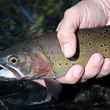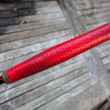In the modern world of Spey fishing, anglers have a multitude of choices when it comes to selecting a fly line. In addition to a variety of lengths, the market offers lines built for specific fishing situations. Below, we'll put the microscope on the Skagit family of lines in an effort to help you make an informed product decision.
Skagit History
Skagit lines were born out of necessity. In the late 90’s, a few elite Northwest anglers realized the effectiveness of presenting very large flies on heavy sink-tips for steelhead. At the time, the average commercially produced lines were 50’ to 60’ long and lacked the ability to turn over such setups. Knowing that mass equates to turn over, these anglers spawned equipment that allowed them to fish these gargantuan offerings. A short, fat line gave them the required firepower. As an added benefit, a shorter line also gave anglers the ability to make a cast with very little back cast room. These first homemade lines were actually shooting heads looped to a mono running line.





























